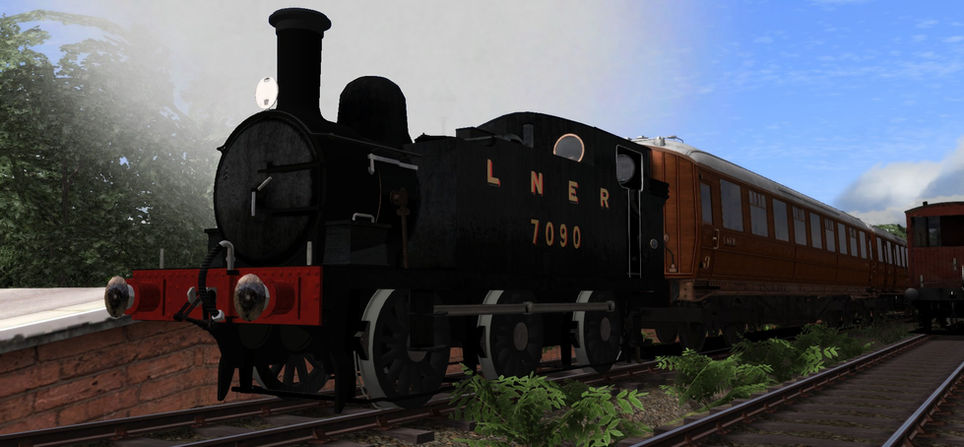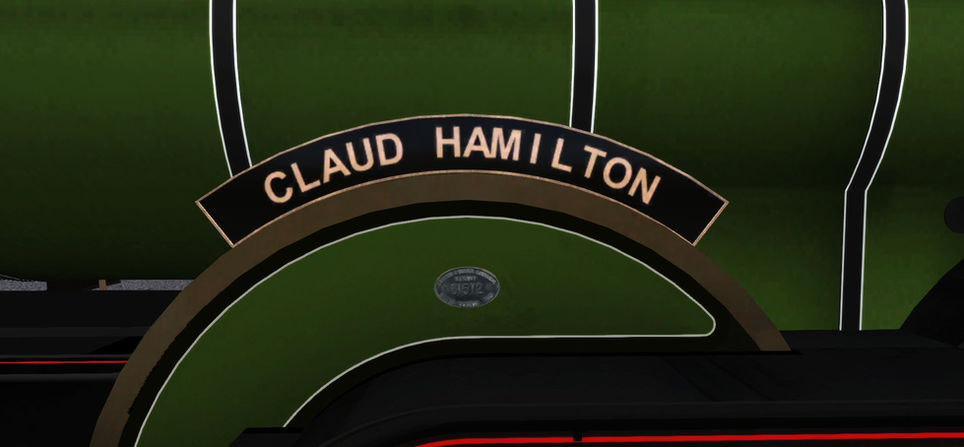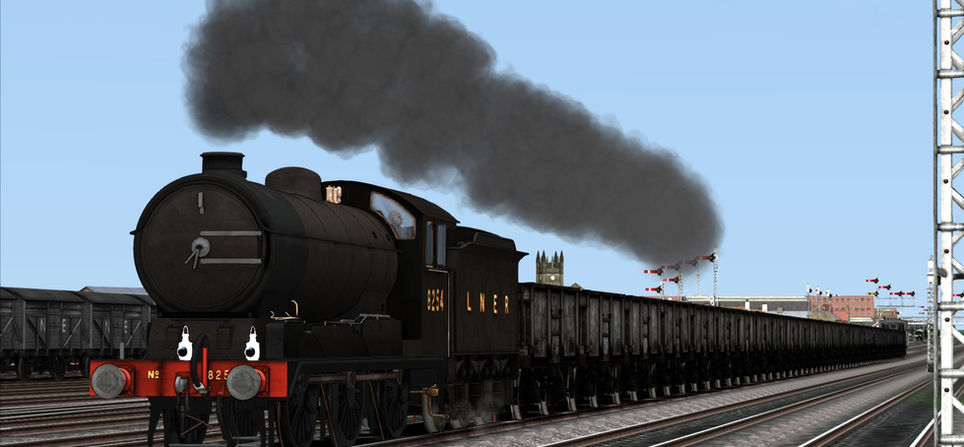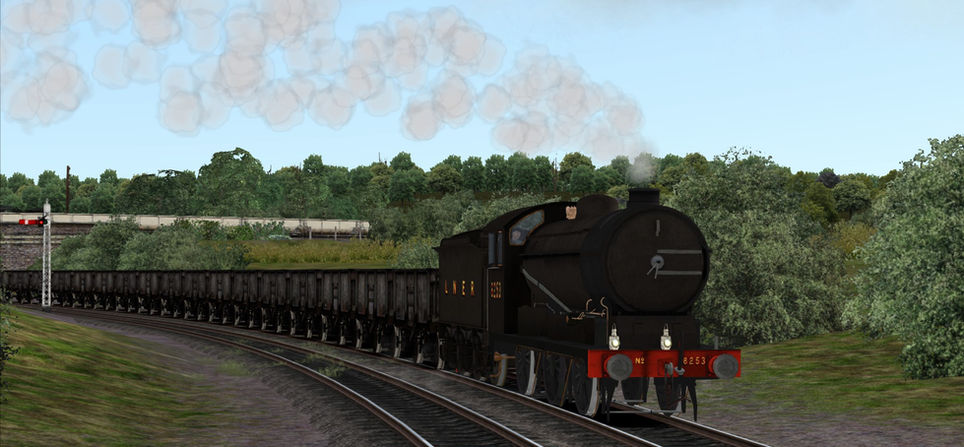

LOCOMOTIVES
This page contains custom locomotive models for use in Railworks
LNER/BR Class B17's Locomotve Pack
Neil Cunningham (cunningn) has been working hard to bring the popular B17 locomotive into Train Simulator (Original Model By Pete Harvey) the original streamlined B17/5 model by Pete on UKTS for Rail Simulator will be required to run this addon and it is certainly great to see this Great Eastern Workhorse being brought to life in the game to fill the gaps in any backdated GEML steam era routes!!
DOWNLOAD THE B17 BELOW!!:
FEATURES -
* 2 Subclasses of B17/5 & B17/6 in LNER and BR Green Liveries
* User-selectable shedcodes, numbers, and headcodes using either lamps or discs
* A full set of 3D nameplates (including those for the 10 B2 conversions just in case Neil gets round to doing the B2s)
* Standard & Westinghouse variations
* The ability to use the water troughs as supplied in the Riviera Line (Exeter to Kingswear) pack
REQUIREMENTS -
* Pete Harvey's B17/5 "City Of London" UKTrainSim
* Digital Traction B12 Locomotive Addon (For Cab, Tender Reskins & Additional Sounds)
* Settle & Carlisle Steam (For 4200gal Tender Reskins)
* RSC Flying Scotsman Pack (For Sounds)
More information can be found in the locomotive user manual HERE
lner/br Class j69 locomotive pack
Neil Cunningham (cunningn) has been working hard to bring the J69 locomotive into Train Simulator (Original Model By Brian Walker Converted From MSTS Into Railworks) The J69 (originally GER Class S56) was a class of 0-6-0T steam tank locomotives designed by James Holden for the Great Eastern Railway. Together with some rebuilt examples of GER Class R24, they passed to the London and North Eastern Railway at the grouping in 1923, and received the LNER classification J69. The Class S56 were a development of the Class R24, being almost identical, apart from higher boiler pressure and larger water tanks. Twenty were built in 1904 at Stratford Works. They started life as passenger-equipped locos (unlike most of their predecessors which were shunting locos) and achieved fame on the famous ‘Jazz Service’ running the most intensive passenger service anywhere in the world at the time from Liverpool Street Station.
FEATURES -
• User-selectable loco number and shedcodes
• User-selectable headcodes using either lamps or discs on front or back
• Passenger and Shunter versions of the basic loco - screw coupling and screw reverser for passenger and 3-link and lever reverser for shunters
• Optional Westinghouse pump
• Optional Condensor apparatus
• Optional Cowlairs’ shunter’s step at the back of the loco.
REQUIREMENTS -
* Rustic Engineman's J15 Locomotive Pack (Steam Sounds Supreme)
* European Loco And Asset Pack
* Somerset And Dorset Joint Railway Route
REQUIREMENTS FOR QUICK DRIVES-
* UKTS Freeware Pack Coaches
* Digital Traction Teak Coaches
* Digital Traction N2 Locomotive Pack
PATCHES-
If you are still having issues with the LNER skin having Alpha Layer issues after downloading this pack and being seen as too shinny please install this patch which should rectify your issues DOWNLOAD HERE
More information can be found in the locomotive user manual CLICK TO VIEW MANUAL
VERSION HISTORY-
V1.0.0
V1.0.1 - Includes Bug Fix For Textures In Railworks Enhancer
V1.14 (Current Version) - Fixes Problems For Non-J15 Users With Loco Not Appearing
- Fixes Issues Of No Shadow Casts From The Locomotive
DOWNLOAD THE J69 BELOW!!:
lner/br D16/3 "Claud" locomotive pack
Neil Cunningham (cunningn) has produced a new fantastic locomotive pack to bring the popular D16/3 locomotives into Train Simulator. The first Clauds were built in 1900 and then in batches of ten in the years following. They were admired for both their graceful appearance and their performance – running the premier services on Great Eastern lines. In the decades that followed they were upgraded and rebuilt several times culminating in the Gresley Rebuilds that were classified D16-3. A total of 104 D16/3s had been rebuilt by 1949 when the rebuilding ceased. From 1924, Clauds were occasionally seen on GNR routes into King's Cross for special passenger services. Typically these would be Royal Trains to Cambridge or King's Lynn. King's Cross to Cambridge workings were greatly extended in 1932 with five Claud-hauled expresses per weekday. A total of 117 Clauds survived to Nationalisation (1948), of which fourteen were D15s. The remaining D15s and D16/2s were quickly withdrawn, with both variants becoming extinct in 1952. Withdrawal of the D16/3s started in 1945. During this period of withdrawal, the Clauds continued to do useful work. They could still be seen on the evening expresses from Liverpool Street to Yarmouth, as well as Saturday extra services. Locomotives from Cambridge were also regularly seen at King's Cross, and the March engines often hauled stopping services to Doncaster. After 1950, the Oxford-Cambridge line was transferred to the Eastern Region and started to be worked by both Clauds and B12s. An odd allocation was that of eight Clauds to the Cheshire Lines in 1949. Seven were allocated to Trafford Park where local ex-LNER men disliked the ex-LMS (London Midland Scotland) types that were being forced upon them. Although the drivers were used to Great Central Railway (GCR) types, they remained loyal to the LNER and liked the unfamiliar D16/3s. They quickly mastered the firing of the shallow Claud fireboxes which contrasted with the deeper fireboxes on the GCR locomotives. One of the main problems with using Clauds on the Cheshire Lines was that it took lengthy periods of time to obtain spare parts from Stratford Works. Reliability of the ageing Clauds began to become a problem in the mid-1950s, and a steady programme of withdrawal started in 1955. No. 62613 was the last D16/3 to be withdrawn in September 1960 from March shed.
FEATURES -
• Highly Detailed D16/3 Model (Including Inside Valve Motion)
• 4 Livery Variants For The D16/3
- LNER Apple Green
- BR Royal Green
- BR Lined Black
- BR Unlined Black
• User-selectable loco number and shedcodes
• User-selectable headcodes using either lamps or discs
• Fully modelled 3D nameplates for "Claud Hamilton"
• User-selectable 3D headboards (See Manual For Details)V
• Accurate soundset and cab analysed to the Digital Traction B12 (Required To Run The Addon)
• The ability to use the water troughs as supplied in the Riviera Line (Exeter to Kingswear) pack
REQUIREMENTS -
* Digital Traction B12 Locomotive Pack (Digital Traction Website)
* UKTS Richard Scott Midland Railway Johnson 4-4-0 (UKTrainSim)
* European Loco And Asset Pack
REQUIREMENTS FOR QUICK DRIVES-
* UKTS Freeware Pack Coaches
* Digital Traction Teak Coaches
More information can be found in the locomotive user manual CLICK TO VIEW MANUAL
VERSION HISTORY-
V1.0.0 (Current Version)
DOWNLOAD THE D16/3 BELOW!!:
lner/br J19 locomotive pack
DOWNLOAD THE J19 BELOW!!:
FEATURES -
• Highly Detailed J19 Model (Including Inside Valve Motion)
• 2 Livery Variants
- LNER Wartime Black
- BR Black
• User-selectable loco number and shedcodes
• User-selectable headcode Lamps
• User-selectable 3D headboards (See Manual For Details)V
• Accurate soundset analysed to the Digital Traction B12 (Required To Run The Addon)
• The ability to use the water troughs as supplied in the Riviera Line (Exeter to Kingswear) pack
REQUIREMENTS -
* Digital Traction B12 Locomotive Pack (Digital Traction Website)
* UKTS Mike Round's K4 Locomotive (UKTrainSim)
* European Loco And Asset Pack
REQUIREMENTS FOR QUICK DRIVES-
* UKTS Freeware Pack Wagons
More information can be found in the locomotive user manual CLICK TO VIEW MANUAL
VERSION HISTORY-
V1.0.0 (Current Version)
Neil Cunningham (cunningn) has produced a new fantastic locomotive pack to bring the J19 locomotives into Train Simulator. The GER Class T77 was a class of twenty-five 0-6-0 steam locomotives designed by A. J. Hill for the
Great Eastern Railway.
They all passed to the London and North-Eastern Railway at the 1923 grouping and received the classification J19. These locomotives were a development of the GER Class E72 (later J18) and shared the same 20-by-28-inch (508 mm × 711 mm) cylinders, 4-foot-11-inch (1.499 m) wheels, and Belpaire firebox-fitted boiler. Changes included vacuum brakes from new, and the abandonment of cylinder tail rods.
All were still in service at the 1923 grouping, the LNER adding 7000 to the numbers of nearly all the
ex-Great Eastern locomotives, including the Class T77 locomotives. Between 1934 and 1939 all were
rebuilt with round-top fireboxes and the boiler used in the D16/3s, and the cylinder bore was
reduced to 19 inches (483 mm). The rebuilt locomotives were reclassified J19/2, while the yet-to-be
rebuilt locomotives reclassified J19/1. The J19/2 classification also included the 10 rebuilt former
Class E72 (J18) locomotives. Although the boilers were rated as 180Psi in the Claud’s they were
reduced to 170PSi in the J19 and then after the war the working pressure was reduced to 160 PSI
across the class as the additional tractive effort was not required. At nationalisation in 1948, British Railways added 60000 to their LNER numbers. They all continued in service until 1959, when the first was withdrawn; all were gone by the end of 1962.















































